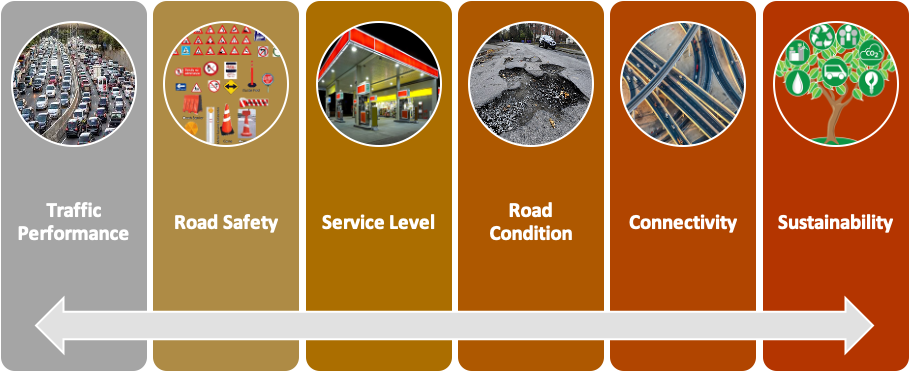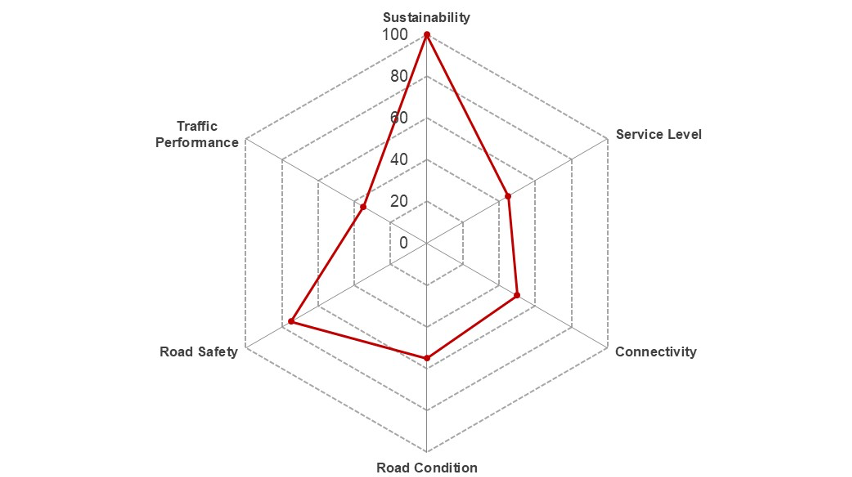The annual Global Competitiveness Report (GCR), published by the World Economic Forum, provides a ranking of countries’ ability to provide high levels of prosperity to their citizens. Its Global Competitiveness Index 4.0 addresses twelve pillars of competitiveness, including an Infrastructure pillar, which in turn includes a transport infrastructure sub-pillar. The transport infrastructure sub-pillar is composed of two elements: road connectivity and the quality of road infrastructure.

The sub-index on quality of road infrastructure is a standard reference today and an often-quoted resource by multilateral banks, governments and globally renowned policy and advisory institutions, including the top consulting companies. The index is unique in its kind, which explains why even the big institutions refer to it as a real measure of the quality of road infrastructure in their key publications. However, the methodology used by the WEF to derive the quality of roads index is subjective, and consequently its validity can be questioned. The index is built on the response by business executives to the following survey question: “In your country, what is the quality (extensiveness and condition) of road infrastructure?”. The possible responses range from 1 (= extremely poor – amongst the worse in the world), to 7 (= extremely good – among the best in the world).
There are several weaknesses in this approach:
- The selection of the sample of business executives to respond to the survey does not guarantee an assessment of a country’s full road network. The surveyed business executives might travel over roads in their country, but it is unlikely that they cover a country’s full network. Furthermore, it is not clear what road network it referred to: motorways, primary roads, non-primary roads, local roads (rural and urban)?
- The sample of executives responding to the survey varies over time; business executives could be participating in the survey in one year but not the next.
- The question posed in the survey assumes that business executives know the quality of roads in other countries (or even “the world”) to sufficiently compare the situation in their own country. This assumption can be challenged.
- The scoring valuation cannot accurately reflect the correlation between costs and benefits of the implementation of road projects or maintenance of roads.
- The objectives that countries may have in terms of the quality of their roads is not reflected in the methodology and can actually vary.
Additionally, from a statistical point of view, there are several objections to the WEF approach, including regarding the scoring scale and the statistics estimators that are used.
In short, the WEF Quality of Road ranking is not an objective valuation of a country’s road infrastructure as it is opinion-based. Business executives are unlikely to be the persons most suitable to provide an expert view on the road “extensiveness” and “conditions”. Overall, the WEF methodology does not include any use of objective data to carry out statistical analysis for a more robust ranking.
A new approach
To solve this issue, Global Road Links has developed a new approach leading to a composite quality of road index, the GRL index. The GRL index uses measurable indicators grouped into several pillars. The pillars included in the index represent the significant aspects of road networks that determine their quality:

Through its composite character, the application of the GRL index is much broader than the original WEF index and enables support to decision-making in road development management. The GRL index is designed to be global and to highlight evidence of trends in countries at different levels of economic well-being and reflecting the relevant local objectives. Applications include:
- Planning for extension and improvements of road networks;
- Evaluating the impact of each pillar on the road quality and prioritisation from the angle of different quality components;
- Benchmarking performance with other countries or between different levels of the road network (national, regional, local) within a country;
- Monitoring and evaluating impact and trends in quality of the road network in countries and objectively link these with network interventions.
The new index is objective and statistically sound, based on accurate and audited data. Every quality pillar is measured through several indicators, the selection of which is based on statistics criteria that include relevance in terms of the composition and objectives of the index, and data availability. The scores and six pillars ensure the index value for each country can be represented in a spider graph, in which the value or “score” is equal to the total surface of the graph created with the scores of the country on each of the pillars.

The arguments for an alternative, composite quality of road index (the GRL index), that is based on objective data, a robust methodology and critical pillars that determine the quality of the road network, are compelling. An objective and statistically sound measure of the quality of roads ensures the substantially broader application of the index.
Global Road Links can help you set up your own composite index for the quality of your road network(s), whether you are operating at national, regional or local levels. Contact us at info@globalroadlinks.com for a free intake to explore what value Global Road Links can bring to you.